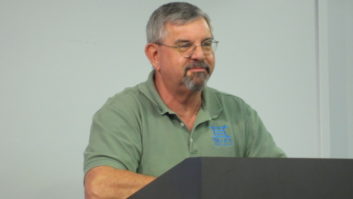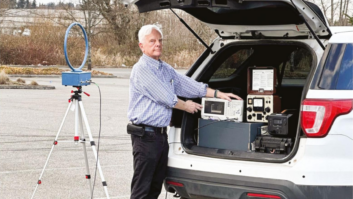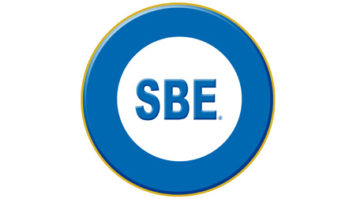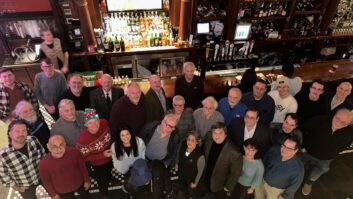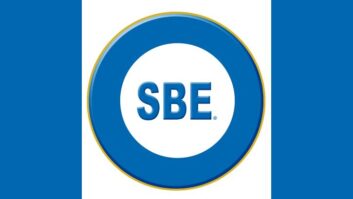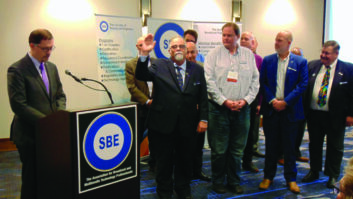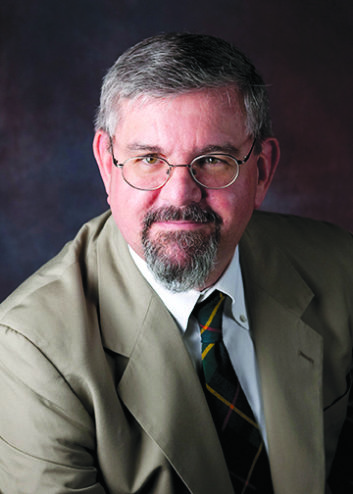
Chris Imlay credits an abiding love of ham radio as one of the reasons he has devoted his career to communications law.
Imlay, 68, retires as general counsel for the Society of Broadcast Engineers at the end of 2021. His tenure in that role began in 1991, but his actual work for the group goes back to 1980 when he took up SBE’s appeal of the FCC decision to eliminate the First Class Radiophone License.
Announcing of Imlay’s retirement, SBE President Wayne M. Pecena said, “Chris Imlay has been a valuable resource for and asset to the SBE over the past 41 years. He has also been a staunch advocate for the SBE’s goals and objectives. He is a tough act to follow.”
Imlay specializes in federal communications law but has represented licensees and associations of communications users, especially technical and electronic communications associations, electronic equipment manufacturers, colleges and universities, in addition to his work on FCC regulatory issues for SBE.
“I still plan to work with a handful of my mom-and-pop broadcasters as clients past the end of the year. I want to make sure they are settled and taken care of as I begin to wind down my practice,” he said. “But I have to give this up at some point and there are other things I want to do.”
Imlay began his legal career in 1975 after graduating from American University’s Washington College of Law. He began practicing communications law in 1979 when he joined the firm Booth and Freret.
It was there that his long relationship with the SBE began. Soon Imlay found himself attending society board meetings and NAB Shows, and providing reports about pending FCC regulatory issues.
Imlay was retained as SBE communications counsel in 1984. In 1991, SBE President Rick Farquhar arranged for the board to confer Imlay with the general counsel title.
Advocacy role
Reflecting on his career, Imlay said, “I have valued my work with the SBE, as it has allowed me to do what I do best: defending spectrum allocations of clients and participating in technical regulatory proceedings. I have always been most comfortable working with broadcast engineers.”
The SBE chief counsel was elected a Fellow of the SBE in 1997, which he still considers the most important honor received throughout his professional career.
Imlay, who has worked with 22 SBE presidents, describes himself as a “down in the trenches” communication lawyer, focused on advocacy and education.
“I grew along with the advocacy program at SBE. It’s been interesting how that happened. I fell in with a very technically inclined communications law firm, and that was a stroke of luck. The very first thing I worked on for SBE and then-President Bob Jones was the appeal of the FCC decision to eliminate the First Class Radiophone License, which interestingly was was very much against SBE’s best interest.
“SBE thought the license signified something and should be preserved. SBE lost, but the appeal did serve as the first step into the waters of advocacy, something at the time the SBE board hadn’t really considered.”
This would signal a major turn in philosophy for SBE and a growing role for Imlay within the organization.
“Spectrum management issues were beginning to become a thing, and SBE thankfully believed this was an important topic for its membership. I never tried to push them in that direction, but gradually we undertook more and more advocacy projects,” Imlay said.
Imlay credits another past president, Richard Rudman, with a leadership role in developing SBE’s more proactive approach.
“He had some important observations about how broadcast engineers needed access to decision-makers and how the broadcast auxiliary spectrum needed protection from encroachment from incompatible sharing partners or being reallocated. This was great foresight, considering what we see currently from the FCC in regards to spectrum management.”
Informing regulators
An early goal for Imlay was making sure people who worked at the FCC understood what broadcast engineers did in the way of program production and ENG.
Under Rudman’s guidance SBE turned the corner in how it approached advocating in FCC dockets dealing with spectrum. But Imlay said Rudman also realized the need to educate FCC staff.
“SBE had never taken an active role in broadcast auxiliary spectrum protection but more a reactive role; we became more active in that. We decided we needed to do more than just make comments in rules proceedings.
“So we organized half-day long presentations to the FCC staff. It was very well received by FCC engineering staff and even non-technical staff. We quickly learned this was a good thing, creating comprehensive awareness of what broadcast engineers do and why spectrum is important to them.”
So began Imlay’s longtime focus on “educational advocacy” and his efforts to ensure that the FCC and those in Congress were aware of nuances of the work of broadcast engineers and how they utilize Broadcast Auxiliary Services.
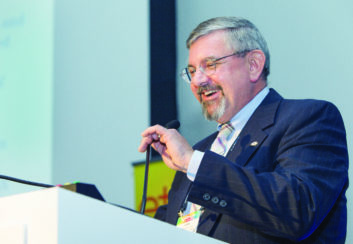
“Today everything I do is generally focused on spectrum issues, everything from advocating for more UHF wireless mic spectrum, following the 600 MHz auction, to making sure that 2 GHz especially, but also 6.5 GHz and 7 GHz are continually available and not usurped by incompatible services,” he said.
“SBE is focused on making sure the scientific integrity of those spectrum compatibility determinations are made as a prerequisite for a spectrum sharing proposal. And that it shouldn’t only be an economic analysis judgment of the FCC.”
In fact, Imlay said a section of the Communications Act focuses on the economic success of spectrum auctions, which forces the FCC to accept proposals based on their potential economic success.
“It’s the policy of the United States to encourage the provision of new technologies and services to the public; so anybody who opposes a new technology, that is proposed to be permitted under the act, has the burden to demonstrate that the proposed service is inconsistent with the public interest,” he said.
“So without assessing anything about the technical integrity of a new proposed service, the U.S. policy is for the FCC to support that service. By definition that puts incumbent services, like broadcast radio and TV, which are considered older technology, at the back of the bus,” Imlay said.
Imlay is known for his work helping amateur and broadcast engineering associations prepare materials in FCC rule making and adjudicatory proceedings.
H said he believes the FCC does a “poor job” of ascertaining spectrum compatibility before making rulemaking decisions. He nevertheless characterizes the technical competency of the FCC as “exceptional and consistently high,” especially in the Office of Engineering and Technology and in the Media Bureau.
“Audio Division engineers are top-notch, to a person, and they are accessible and helpful. That said, they are not always consulted by the bureau front offices when technical decision-making occurs. But they should be,” Imlay said.
Defining an “engineer”
The attorney recalls some “wins and losses” through the years. One important victory was preventing states from implementing statutes that required broadcast engineers to register with the state and obtain a PE certificate.
“The effect of these statutes, which were intended to protect the public, meant broadcast engineers couldn’t call themselves engineers. Our position was and still is that broadcast engineering is a different animal than civil or mechanical engineering. Broadcast engineers work in facilities solely under the jurisdiction of the FCC and states have no jurisdiction to regulate the practice of broadcast engineering,” Imlay said.
“These statutes were clearly not in the interest of broadcast engineers. We had some good decisions in Texas and Oregon; and we don’t seem to have those issues today.”
SBE did end up losing a battle to prevent numerous FCC field offices from closing a few years ago.
“We took the issue to Energy and Commerce Committee members in the House and to Commerce Committee members in the Senate. The aggregate loss of engineering talent when the field offices closed, and the loss of rapport and positive working relationships with broadcast engineers caused by the forced retirement of experienced FCC field engineers, was a nightmare. We have visited with House members in an effort to restore some of that talent, and continue to do so,” Imlay said.
There are issues on which SBE continues to seek action, including background noise on the spectrum. The society believes the commission lacks a good basis for determining levels of ambient, manmade RF noise in various allocations.
“The FCC relies heavily now on spectrum overlays and the interference temperature of receivers, and it uses those concepts in determining what radio services can be combined in the same bands. That presupposes that the FCC knows how much noise there is in various RF environments,” he said.
“SBE’s frequency coordinators know their markets very well and they know what works and what doesn’t, but FCC doesn’t have any idea what those levels are,” he said.
Imlay, points to SBE’s certification program as the “flagship” of SBE educational services.
“Without exception, I have found SBE presidents, folks like Chriss Scherer and Richard Rudman and really all of them, to be team-spirited folks not interested in self-promotion at all.”
The SBE has 5,000 members and 114 chapters across the United States. It will split Imlay’s responsibilities, planning to retain an Indianapolis attorney for association business matters.
“I believe they have already found an Indianapolis law firm to help with corporate and tax type issues, which isn’t something I really did anyway. The important part of finding a successor to me is finding somebody who is skilled in spectrum allocations and spectrum management issues,” Imlay said.
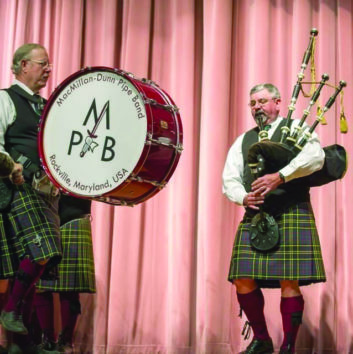
Imlay, described as a spectrum expert by many in the industry, says he spent countless hours of his career writing comments on behalf of SBE for FCC spectrum dockets, which would have been for naught without the expertise of practicing broadcast engineers.
“As technically oriented as my law firm is, I’m not a broadcast engineer. I have to rely on fact-gathering of SBE board members, the SBE Government Relations Committee and leaders of our frequency coordination program. All FCC responses are very collaborative efforts,” Imlay said.
Imlay resides with Rita, his wife of 41 years, in Cloverly, Md. The couple has two children, Bonnie and Ashton, and two grandchildren, Simone and Langston. (“So far, only one of the family is an engineer,” Imlay said.)
Since 2014, Imlay has been managing member at what is now called Booth, Freret & Imlay LLC. He said he hopes to find a balance in order to work two or three days a week and have more time to fish and play his favorite musical instrument.
“I have 24 acres in western Maryland that I manage and do forestry on the weekends. I just haven’t had the time to enjoy that,” he said.
“I’m also a dedicated bagpiper. I go to all the Highland games in the area. I compete in solo and band competitions. In fact, I have studied with some of the old masters in Scotland. I just love the sound of the instrument and the emotive sound of it,” he said.
Imlay has all kinds of interests to pursue in semi-retirement. “I haven’t been up any of my three ham radio towers in way too long. I have rotators that don’t work. I have coax and antennas to replace. And I need several new transceivers, so I want to stop and smell the RF for a change,” he said with a chuckle.
Comment on this or any story. Email radioworld@futurenet.com.
